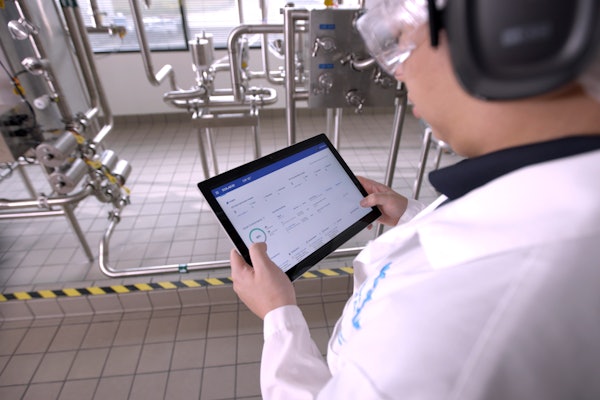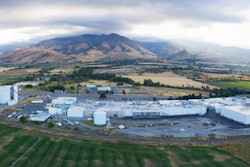Three keys to global food security, according to Vivien Sheehan from the Kerry Group, are regenerative agriculture, eliminating food waste, and sustainable protein. Sheehan presented her path to overcoming challenges in maintaining a secure food supply during her keynote address at the recent Global Midwest Alliance conference in Chicago, which focused on novel ways to enhance the safety, quality, and nutritional value of food.
“Food security means that all people at all times have physical, social, and economic access to sufficient, safe, and nutritious foods that meet their dietary needs,” Sheehan says.
Sheehan—global vice president, research development, applied health & nutrition at Kerry—says this path is currently faced with global crises, including the war in Ukraine and climate change. Here, in her own words, are some of Sheehan’s key takeaways for how to address the hurdles facing global food security now and in the future.
Defining the challenges
Sheehan: Are we innovating globally at the pace needed to ensure global food security? We’re probably not, because we’re faced with a lot of different crises at the moment, and we have a very fragile food system. Ukraine is known as the breadbasket of Europe, and the war there creates challenges with the ports. Also, we have extreme weather leading to world hunger. As our temperatures and sea levels rise, it increases heat waves, dry conditions, and ultimately wildfires, which will impact our ability to feed a growing population. How we navigate these serious global food challenges will indicate how well we cope in the future.”
The significance of 2050
Sheehan: The global pursuit of net zero emissions by 2050 is a huge undertaking. By 2050, the global population is expected to swell from 7.9 billion people to almost 10 billion people. With this, we will require 50% More food and 70% more animal protein to feed everyone. That means we would need the resources of three to four planets to accommodate our dietary needs. Complex problems require holistic solutions and collaboration among policymakers, farmers, food manufacturers, and the food and beverage industry. Innovation and government regulations will not be enough to meet our targets, and as an industry, we need to instill responsible culture changes in our businesses and to consumers. We need to make smart decisions to deliver radical improvements to ensure that future generations have a food system that meets their needs with the available resources.
Regenerative agriculture
Sheehan: Soil quality is the beginning of a stable food system, and our industry depends on it. When soil is damaged, carbon goes back to the atmosphere, drying out that soil and turning it to dust—this is a process called desertification. It’s estimated that by 2050, 1 billion people will be refugees to soil desertification. Since chemical agriculture accelerated in the 1970s, we’ve lost a third of the world’s topsoil, and if we don’t take steps to reverse this trend, we’ll increase our emissions and reduce the soil base carbon sinks which will result in us exceeding the global warming limit of 1.5 degrees Celsius.
A healthy soil achieved from regenerative farming practices can bring our carbon down, capture it and put it in the ground. Soil microorganisms have this unique ability to capture the carbon and make it carbon blue. So, ensuring mass adoption by incentivizing farmers, offering education programs, and facilitating a move to renewables is fundamental in the transition to sustainable agriculture. If we accelerate the shift to regenerative agriculture, it will make an enormous contribution to futureproofing our food system.
Food waste
Sheehan: If food waste were a country, it would be the third largest contributor to global greenhouse gases. Addressing food waste hinges on leveraging preservation solutions that we have today to extend the shelf life of the food we have, and then working to positively impact consumer behavior. Meat for example is the most carbon intensive category of all food waste offenders, and each year 73 billion kilograms (161 billion pounds) of meat is wasted annually. That’s the equivalent of 2 billion portions a day.
Looking at the bakery industry, this represents the largest volume of global food waste with nearly 12 billion loaves wasted annually. That’s the equivalent of 630 million slices every day. So, tackling the shelf life of bread in a holistic manner is critical. Preservation ingredients with a lower environmental impact will unlock huge value in this area. However, while we scale innovation solutions, the existing conventional and clean label preservation ingredients to reduce food waste now is key. Our ambition is ultimately to achieve a fully circular economy, whereby we’re designing waste upfront, or converting waste into revenue generating waste streams, like taking stale bread and using it in the brewing industry as a fermentation substrate.
Sustainable protein
Sheehan: Over the last 50 years, meat production has more than tripled. However, based on the calories obtained from animal products, it’s difficult to support the carbon footprint and resources required to produce them. So, protein transition technologies like biotechnology, protein derived from fermentation, and precision fermentation, are all new technologies that allow us to be more sustainable and innovative in our ways to feed the planet. Biotechnology coupled with fermentation provides a powerful process in an efficient, sustainable way to produce alternative proteins. It offers us the opportunity to take readily abundant substrates, such as low-cost waste streams and convert them into high-value products.
We can leverage advances in biotechnology to nourish growing populations sustainably, reducing our dependence on chemicals, and enhance efficiency with respect to raw materials while reducing carbon dioxide emissions. We’ve never had better tools to optimize the microbial strains that are leveraged in this process to ensure consistent and environmentally friendly solutions. Biotechnology can also enable the development of different plant protein plants to express everything from casein proteins to heme from meat.
Future forward
Sheehan: While consumers say they want sustainably produced food, are they willing to pay for it? Are businesses willing to invest in the capital to transition from fossil fuels? At a time when there’s record inflation and vulnerable supply chains, paying more for responsibly sourced materials can seem risky, but businesses with a longer-term perspective will see the advantages. Making sure we’ve got the appropriate funding mechanisms to manage the cost burden to support our industry is key.
























